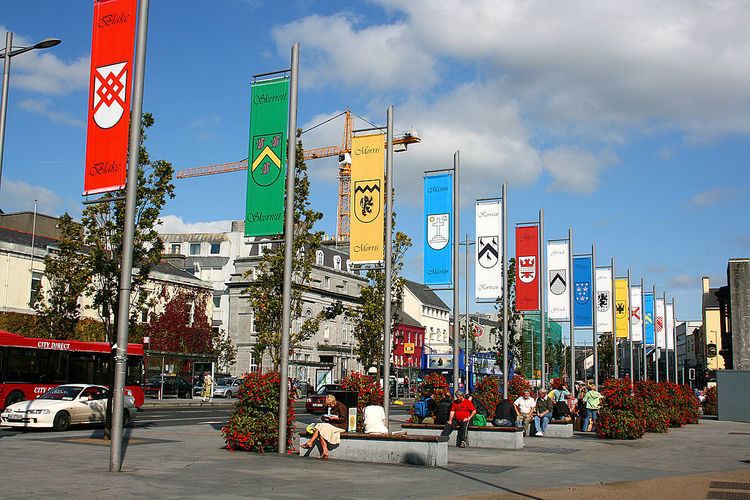The Tribes of Galway (Treibheanna na Gaillimhe) were fourteen merchant families who dominated the political, commercial, and social life of the city of Galway in western Ireland between the mid-13th and late 19th centuries. They were the families of Athy, Blake, Bodkin, Browne, D'Arcy, Deane, Font, Ffrench, Joyce, Kirwan, Lynch, Martin, Morris and Skerritt. They were of mixed origins, variously Norman, Hiberno-Norman, Gaelic-Irish, French, Welsh and English, or some combination of the above.
The Tribes were merchant families who prospered from trade with continental Europe. They dominated Galway's municipal government during the medieval and early modern eras.
The Tribes distinguished themselves from the Gaelic peoples who lived in the hinterland of the city. However the feared suppression of their common faith joined both sides together as Irish Catholics after the Irish Rebellion of 1641 ( for many Irish was already a second or even first language). During the Irish Confederate Wars (1641–1653), Galway took the side of the Confederate Catholics, and as a result the Tribes were punished following the Cromwellian conquest of Ireland. The town was besieged and after the surrender of Galway in April 1652, the Tribes had to face the confiscation of their property by the New Model Army.
The Tribes lost much of their power within Galway city after English Parliamentarians took over the Galway Corporation in 1654. Because of the uncertain response to this dilemma by the merchant families, Cromwell's forces referred to them by the derogatory name, "The Tribes of Galway", which they themselves later adopted as a mark of defiance.
Galway's urban elite enjoyed a measure of their power restored during the reign of the King Charles II (1660–1685) and his successor James II. However, Jacobite defeat in the War of the Two Kings (1689–91), marked the end of the Tribes' once overwhelming political influence on the life of the city, which passed to its small Protestant population. Garrison members of the Tribes who owned land in Galway and Mayo were protected by the advantageous surrender provisions that were signed on 22 July 1691.
Margaret Athy, fl. 1508, founder of the Augustinian Friary of Forthill.John Blake fitz William, third Mayor of Galway, 1487–1488.Captain James "Spanish" Blake, fl. 1588–1635, spy and purported assassin of Red Hugh O'DonnellJoaquín Blake y Joyes, 1759–1827, Spanish military officer who served with distinction in the French Revolutionary and Peninsular wars.Sally Blake, landowner and duelist, 1774–1870.John Bodkin fitz Richard, Mayor of Galway, 1518–19.Dominick Dáll Bodkin, mass murderer, executed 8 October 1740.John Bodkin, Roman Catholic Warden of Galway, died 1710. After his death, his body was said to have been the subject of a miracle because it was thought to have not decayed.Leo Bodkin, (1879– 30 August 1919) was a British military officer and writerMichael Bodkin (c.1888–1900), inspiration for Michael Furey in James Joyce's short story "The Dead"Geoffrey Browne, Irish Confederate lawyer and politician, died 14 January 1668Mary Bonaventure Browne, Poor Clare and historian, born after 1610, died after 1670John Browne, 1st Marquess of SligoGarech Browne, born 1939, patron of Irish arts and one-time manager of The ChieftainsJames Riabhach D'Arcy, Mayor of Galway, 1602–1603.Patrick D'Arcy, 1598–1668, Catholic Confederate and lawyer who wrote the constitution of Confederate Ireland.Count Patrick D'Arcy, 1725–1779, mathematician and soldierEdmond Deane, 18th Mayor of Galway, 1502–1504Geoffrey Font, centenarian, 1709–1814Christopher French, Theologian, fl. c. 1650-c.1713Sir Oliver Óge French, Irish nationalist, died 1666Seán an tSalainn French, 1489–1546, was Mayor of Galway from 1538 to 1539Arthur French, 1st Baron de FreyneConrad O'Brien-ffrench, artist and secret agent, 1893–1986Henry Joyce, Mayor of Galway, 1542–1543Richard Joyce, c. 1660 – c. 1737, creator of the Claddagh RingWilliam Joyce, aka Lord Haw-Haw, fascist and Nazi, 1906–1946James Augustine Aloysius Joyce, (2 February 1882 – 13 January 1941) novelist and poetPatrick Weston Joyce (1827 – November 1914) historian, writer and music collectorDominick Kirwin, Irish Confederate, fl. 1642–1653?Joseph W. Kirwan, 1796–1849, first president of Queen's College, GalwayMagdalen Kirwan, c.1830–1906, Sister of Mercy and manager of St. Vincent's Industrial School, GoldenbridgeRichard Kirwan (1733–1812), president of the Royal Irish AcademyRisteárd Buidhe Kirwan, soldier and duellist, 1708–1779Sarah Annette Kirwan, d. 1913, first wife of Sir Edward Carson, Ulster Unionist leaderAnthony Lynch, Dominican and Barbary captive, c. 1576-after 1636Christopher Lynch, Mayor of Galway, fl. 1601–1604Dominick Dubh Lynch, died 14 August 1508, second Mayor of GalwayGermyn Lynch, fl. 1441 – 1483, merchant and entrepreneurIsidore Lynch (1755–1841), soldierJean-Baptiste Lynch (1749–1835), Mayor of Bordeaux and a peer of FranceJohn Lynch, 1599?–1677?, historian and Archdeacon of TuamMaire Lynch, Countess of Clanricarde, fl. 1547Thomas Kerr Lynch, explorer, 1818–91Edward Martyn, 1859–1923, political and cultural activistFrancis MartinMary Gabriel MartynMary Letitia Martin, 1815–1850, writer.Peter Martin (STP)Richard Martin (1754–1834) was a long-time advocate of Catholic Emancipation and a founder of The Society for the Prevention of Cruelty to Animals.Richard Óge Martyn, c. 1602–1648, member of the Catholic Confederates of IrelandViolet Florence MartinWilliam Óge Martyn, Sheriff and Mayor of Galway, fl. 1566–1592Andrew Morris, Mayor of Galway, 1588–1589Lieutenant-Colonel Hon. George Henry Morris, 1872–1914, commanding officer of the Irish GuardsLord Killanin (1914–99), sixth president of the International Olympic Committee 1972–80, was a descendant of the Morris tribe. His sons are the filmmaker, George Redmond ("Red") Morris, and horsetrainer, Mouse Morris.Mouse Morris, born 1951, racehorse trainer and former jockeyJohn Skerrett, Preacher and Missionary, c.1620-c.1688Nicholas Skerrett, died 1583, Archbishop of TuamLike all Irish counties Galway has a nickname. The nickname the tribesmen is now used for the county and its people and is derived from this term.
The tribes also lend their names to fourteen of the city's roundabouts located in or around the city's boundaries. The roundabouts are signposted on navy blue signs containing the tribe's name in the Irish language

